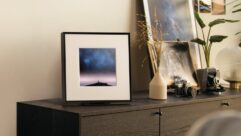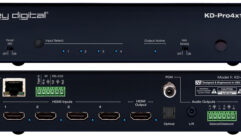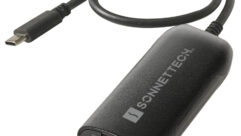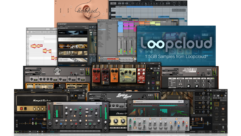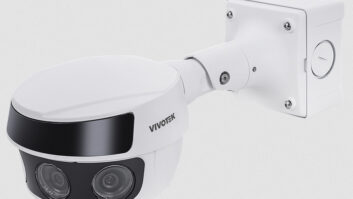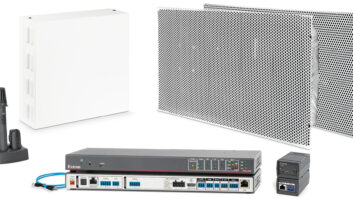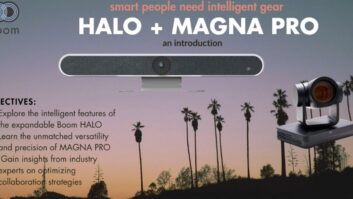
Stagetec Nexus at the NBA Finals, Part 2
Oct 11, 2011 12:59 PM,
With Bennett Liles
Listen to the Podcasts
|
Editor’s note: For your convenience, this transcription of the podcast includes timestamps. If you are listening to the podcast and reading its accompanying transcription, you can use the timestamps to jump to any part of the audio podcast by simply dragging the slider on the podcast to the time indicated in the transcription.
This year’s NBA Finals were watched by millions and the task of getting the signals from their sources in the Dallas American Airlines Arena to the ESPN broadcast was on the shoulders of Stagetec and its Nexus network. Stagetec President Russell Waite is back to wrap up his chat about how the Nexus network carried the show. That’s coming up next on the SVC Podcast.
Rusty, thanks for being back with me on the SVC Podcast for part two on the Nexus network that was set up for the NBA Finals in the American Airlines Arena in Dallas. A lot of remote trucks, a lot of feeds going on, and we were talking about how the Nexus network did all of this. So when you got out there, what was the time frame on getting all of this up and working?
First of all, thanks. It’s great to be a part of this and I hope we can get into a little more in-depth questions in Part 2. I hope everybody’s sticking around. It’s interesting the question that you’re asking. As with any network the better you plan in advance the better it’s going to come out in the end, but it is a modular system so even at the last minute we can add some cards in there if you really need to and just make it work. But the time frame I guess for the NBA…I mean, CP Communications, I guess they really started a couple months beforehand—configuring what is it that we’re going to need, how many places, where, what are we looking at in terms of the arena, where do we have to lay down these pieces. It’s not the first time that they’ve done these types of events. What we really did and what was really the big part of it this year was we were moving the NBA Finals from copper for the audio to fiber and I said, it was really for the A1’s a bit of a task to re-think how they were setting everything up, understanding how Nexus was/is working. For a lot of them it was the first time that they’ve ever seen it—heard about it—but I have to say it was a great reception all around from them and I have to say in terms of planning you can never plan enough before the events. Setup wise, it’s relatively smooth. We work with you during the planning stages and we set up all those base devices and I’ll draw them up—my team will draw them up—and we’ll lay them out across how you think it’s going to look for the whole venue and we’ll run it that way and just making sure that all the signals that we need are checked off and everybody’s getting what they need, and so we set it up. It depends on the event—events like the Olympics, they start very early. We’re a year away but we’re already starting to plan how the Nexus boxes are going to be set up across the venues so physically we’re not going to be delivering anything until June-July. But obviously on paper…you can never start too early I guess is what I am trying to say right now. [Timestamp: 3:27]
Yeah, and with a very high-profile event like this with lots going on, you’re sort of at ground zero. There’s got to be a lot of communication between the people who are taking those feeds and making sure that they have what they need and if there are any problems that come up, that they’re fixed very fast. So what was it like being in the middle of all that?
Well it’s interesting…there was a lot of habits that have been developed over the years, which I think is great. Obviously faxing of the systems, everybody needs to know that they’re getting the sources where it’s coming from and pushing through…you want to send tone through everything, you want to make sure that the signal’s actually there and you find mistakes, right but the great thing about the Nexus is once she’s there and up and running and everybody’s happy it’s constantly actually going over and seeing that it’s running diagnostics in the background and making sure that everything’s there. It’s pinging the different nodes, or what we call base devices, making sure the communication’s OK and then we’ll alert anyone that’s actually on the network whether there is a problem. They’ll be a pop up and basically say, “Hey, we’re getting close to heating.” It’s interesting when we talk about the NBA Finals because Dallas, they’re still going through a heat swell over there but we were hitting temperatures of 105 degrees and then the base devices were sitting out in the sunlight, right in the sunshine basically and they were getting quite hot but they’re built to military specs so they can handle all this. [Timestamp: 5]
And of course you have to have power and a lot of things can happen power-wise especially in a temporary setup. How did you have that set up for reliability, is there an optional failover on the Nexus system?
Well, on every one of the base devices nodes we have dual power supplies—automatically switch over with no loss of audio so there’s no click whatsoever. And then it’s the same on the Star so actually for the NBA Final’s we had a Star system so we home-runned a lot of the base devices to the Star. So they had a direct fiber connection with the main Star unit. Every piece of the system has dual power supplies because you never know, as you say, what can happen, but CP actually had every unit installed nicely into a case and they had a UPS system on every case and so even if there was any interruption in power supply, they had enough time because the power draw of a base device is so minimal. It’s less than a couple hundred watts so it’s nothing really off of a UPS system. So they could have just ticking and ticking but luckily, knock on wood, there wasn’t any problems to do with power and everything went off real well. [Timestamp: 6:24]
Stagetec Nexus at the NBA Finals, Part 2
Oct 11, 2011 12:59 PM,
With Bennett Liles
And on the TrueMatch digital mic pres we were talking about in Part 1, each one is handling a lot of outgoing signals. How does that work? Who has the ultimate control over it in a multi-feed situation like this?
Well it’s funny, with the GUI control you can set up a hierarchy so you tell us how would like it to happen, and typically it’s a sub mix that takes over the control of the mic pres in a broadcast like this because the main production truck is looking after everything else that’s going on right and especially dedicated onto the announcers. But you can have multiple areas of control that’s totally up to the operators to decide—or the team that’s going to be doing it. But as I said before you can have up to four splits of the same mic source so production can have a totally different mic gain structure than the sub mix so that flexibility is built into the system and that’s just something that everybody needs to decide for themselves. I guess as we move more and more into the digital realm and people…this isn’t anything new to them, having to deal with who has got control over the mic pres. What maybe here is new is that you don’t need a passive or active splitter. This is built into the Nexus so it’s still the same unit. Its one LXR connection and pumping out of the other side are four independent outputs of that same microphone. [Timestamp: 7:5]
And when you sort of ran the tests on this to see if it was going to stand up to a real world remote broadcast did you actually put it through any power loss things? How long does it take to come back up if that were to happen?
When you’re showing people how this all works they’re always interested to see what happens. The Nexus-based unit—we’re talking a couple of seconds really before she’s up and running again. The other thing, I think, when you’re looking at routers and stuff like that, so if you lose fiber connectivity or anything like that, I like to show the A2’s that if this accidentally pulls out A, you have a redundant run. But just check out how quickly she locks and she locks in about five seconds to the mainframe and then all communication is there, right so it’s nice. The redundancy, I really have to take my hat off to the engineers at Stagetec—they really have this thing planned through and this is what we do—we do live theater and broadcasts. This is the only market truly that we live in and it’s 24/7. The equipment just needs to be running and everything else needs to be built in. So that you need to be able to come back when she’s turned on—comes back to the same state as it was before, anything like that. So I’m proud to be part of a team that really takes this seriously and looks at tests and different areas and we’ve benefitted from many years of being in this area. Again, here in the U.S., I guess people aren’t that familiar with us, but we’re certainly getting there. And this with the NBA Finals, we’re quite proud because it was a test bed for other remote venues and we just finished installing the Monday Night Football systems and that’s going to go rolling out this week so the first game’s going to be in Miami where the Nexus is going to be a part of it. So every Monday Night Football Game for the rest of the season’s going to be on a Nexus system and RS digital console. [Timestamp: 9:58]
Alright, straight from NBA to NFL.
Yeah, I always wondered why those NFL football trucks were always at the NBA Finals but… [Timestamp: 10:07]
Well, you’ve already put it through its paces on that and I don’t think there’s any more brutal environment on hardware and crew than doing sports remotes.
Yeah, they really need 150 percent out of the equipment and the people that come and handle that—there’s some great guys that are out in the field doing this. They demand the best and we’re here trying to give them the best. It’s great to be recognized as having really sound equipment that’s quite easy to set up and is alleviating some of the stuff that they normally had to worry about. There’s no more tweaking from the front ends to get this to work and if she shines up and is connected by fiber you’re basically good to go. And now we’re just people getting confidence and using the system more and more and understanding the way that it works. You don’t have to worry about tweaking it—she’s tweaked already to the most optimal moment and she can. You can set it up any way you want. If your gain structure—obviously that’s still something that everybody’s still going to be doing their own way but in terms of having a complete network set up there and having it managed and properly looked after, the Nexus really does get into the thick of it and can really make your life simpler on a remote and facility-wise. It’s just amazing how long it takes to bring it in front of people and I’m just glad that we were given the opportunity to do so and that we’re now seeing some success and we’re proud to be part of the remote business really. [Timestamp: 11:53]
Alright, Rusty Waite with Stagetec USA and the Nexus network and the NBA Finals handling audio and communications and thanks a lot for being with us to tell us how it all happened there.


